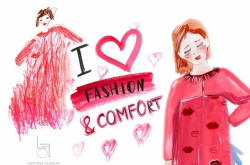How fast does the fashion-technology synergy go?
I won't say that it’s synergy. Technologies don't really change the fashion industry. It is more like they've highlighted the gaps and offered new opportunities for both consumers and entrepreneurs. One can say that technologies created the background for a new industry.
Surely, the most evident results are those we can see, feel or touch - smart fashion items and technologies such as virtual dressing rooms or creating 3D models for particular customers, robot tailors and so on. Yet, there are also "invisible" technologies that affect the fashion industry as a whole, from design and manufacturing to distribution and sales. For example, that would be anything that has to do with predicting trends based on data analysis, deciphering cultural codes that affect the customer's choices, and the like. Selling has already been affected by systems that find similar items and virtual dressing-rooms.
The integration of technologies and the overall development of new technological fashion industry in Russia is seen as a whole independent field by the National Technology Initiative - FashionNet, there have been hackathons dedicated to it, and recently, the Fashion Futurum conference took place in Moscow as part of the Mercedes Benz Fashion Week. More than 30 global leaders in the field of fashion from nine countries discussed the modern tendencies and pressing issues of today's fashion industry. You moderated one of the panel discussions at the conference. Please tell us about the conference's results and whether the fashion industry is ready to respond to the new challenges.
I'd like to note that it was an excellent event. There were interesting discussions that covered all the necessary aspects of the fashion industry, as well as a pool of renowned experts. Among them were such people as Marvin Liao, co-founder of 500 Startups (USA), Amanda Parkes, Chief of Technology & Research at Manufacture NY (USA), Eddie Mallon, CEO of Launchmetrics, a company that works with Big Data for design. Representatives of governmental organizations also took part in the conference - from the Russian side, that was Victor Evtukhov, Vice-Minister for Industry and Trade, from the French side that was Pascal Moran, executive president of the French Fashion Federation, and many others.
 ITMO University. Konstantin Karmanchik
ITMO University. Konstantin Karmanchik
Not only did the participants discuss how technologies change the fashion industry, but also brought up different issues related to fashion startups and small businesses founded by designers. They've come to the unexpected conclusion that investing in small designers is almost useless due to high risks - and this situation won't change until the new technological ecosystem will be completed, as bringing them into the market will cost more than production.
So, how does this ecosystem need to be organized, and when will investing into fashion startups become profitable?
All of the new technologies that can be used in the fashion industry are to become part of normal business processes. Those are the "visible" technologies I mentioned - digital printing, robots, 3D printing, and the invisible technologies that have to do with data collection and processing, automation of business processes, including monetizing the designer's work, as they will become the new industry's main stakeholders.
 Credit: russmodamag.ru
Credit: russmodamag.ru
The invisible technologies might well be the most promising field. Surely, most of them are to be finalized, but even what we have now can be combined into business chains and experimented upon in business incubators and accelerators. These business chains will become a great instrument for many independent designers, allowing them to enter the market. What I want to say is that alongside new materials, information and communication technologies are now the key promising segments one can work with.
One of Big Data's main advantages for representatives of the fashion industry is defining their target audience more precisely: this way, a designer can predict what his new collection should be like judging from the market's demands, and know how and whom to sell it to. How does it work, and what opportunities does Big Data offer?
In what has to do with defining the target audience, the promising technologies are those used for creating new metrics based on indirect data on customers. This works at the confluence of many sciences, enveloping cultural anthropology and evolutionary psychology, Big Data and digital media. Interpreting data from social sciences with mathematics can lead to a revolution in design, production and distribution. And that has to do with more than just clothing and such.
 Clothing created on a 3D printer. Credit: fashionunited.ru
Clothing created on a 3D printer. Credit: fashionunited.ru
How can the use of Big Data help consumers?
If we're talking about the ideal situation, it works as follows: I need to dress up for an event on Saturday, and some service offers me several ready-made solutions based on my goals and preferences, even though I myself cannot describe them. As a result, I am all ready by Saturday. It is something like an all-seeing eye.
And what if someone doesn't want to be under its gaze?
A fun thing is that it's another great idea for a startup - managing personal data. Anyways, we are moving towards the situation when privacy will cost money, as we get a lot of things for free. That is why we can expect commercial solutions that will provide balance between openness and the use of free products and services. Naturally, that doesn't include personal data that is protected by law. Yet, I believe that the percentage of people who want to cut off from the world is not that big. For example, you like red sweaters, and the system knows it, so what? Customers are generally all right with such things.
 Credit: fastsalttimes.com
Credit: fastsalttimes.com
Let's talk more about those who want the system to offer ready solutions. How will it work?
Ideally, that would be similar to a controller with a single button. The consumers want AI to limit their choice as much as possible. Nowadays, a person has little spare time - let's say, one and a half hours a day, when he has to choose what clothes he needs to buy or decide on what movie to watch, so catalogues don't work anymore.
And if a service will offer the user just three options that were based on his preferences, that would be great. Well, maybe not three but ten or fifteen - but not like now, when even after using all the possible filters you get a thousand choices. This is the problem with being a consumer, and technologies that have to do with Big Data and machine learning can solve it. And I believe that if ITMO University will get onto it, in a couple of years we can expect more than just serious research results, but whole new startups in this field.
 Ivyrevel - an application for choosing clothes. Credit: uk.businessinsider.com
Ivyrevel - an application for choosing clothes. Credit: uk.businessinsider.com
What will help ITMO University in particular to involve itself in the development of FashionNet?
ITMO University has many competencies necessary for creating the above-mentioned “invisible” and possibly the most important part of the new fashion industry. That is everything that has to do with Big Data, machine learning, semantics and of course programming. It's worth mentioning that the range of technologies that is necessary for developing the fashion industry is almost the same as the ones necessary for the new media industry, retail, e-commerce and even eLearning. Surely, the university won't work on it all by itself - it will need partners both in Russia and abroad, and we can already think of several ones. For instance, it would be good to collaborate with Launchmetrics, as well as Ravensbourne University which is already our partner.
What about other fields, optics, for instance? Apart from the Fashion Futurum conference, there also was an exhibition where graduate students from ITMO's Higher School of Light Design presented their recent results. What do you think of this field's development in the future?
Anything that has to do with optics and light is the university's key competence. We have a lot of groundwork in this field, and I believe we shall work on new projects for future events. This demonstrates that our students can create products that draws attention and can be successful. Also, this means that ITMO University has the potential to develop whole new business chains for the fashion industry.
 Jewelry with dynamic lighting Project by Master's students from ITMO's Creative Light Design School
Jewelry with dynamic lighting Project by Master's students from ITMO's Creative Light Design School
What steps should the university take in order to apply its inventions, in the field of fashion industry as well?
Apart from being part of the National Technology Initiative's FashionNet, I think we can already launch a research project on new metrics on consumers, products and media content - its results can become the basis for a whole range of startups in different fields. Amongst other things, smart fabrics and items are most promising. I believe we should look for projects in this field, even if they are on initial stages, and develop them at the Future Technologies accelerator. What's more, we have to actively collaborate with our foreign colleagues that have competencies we can make use of and connections on the global market.





